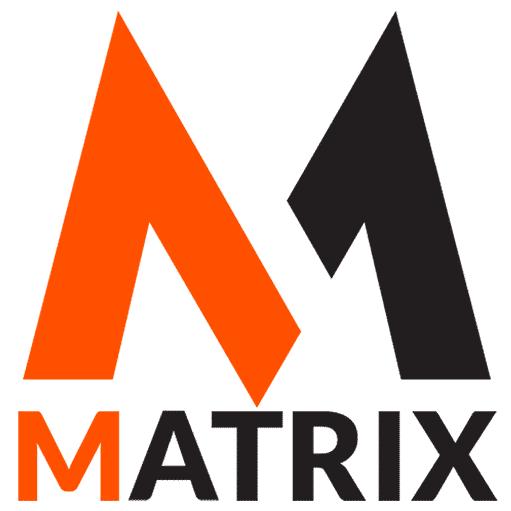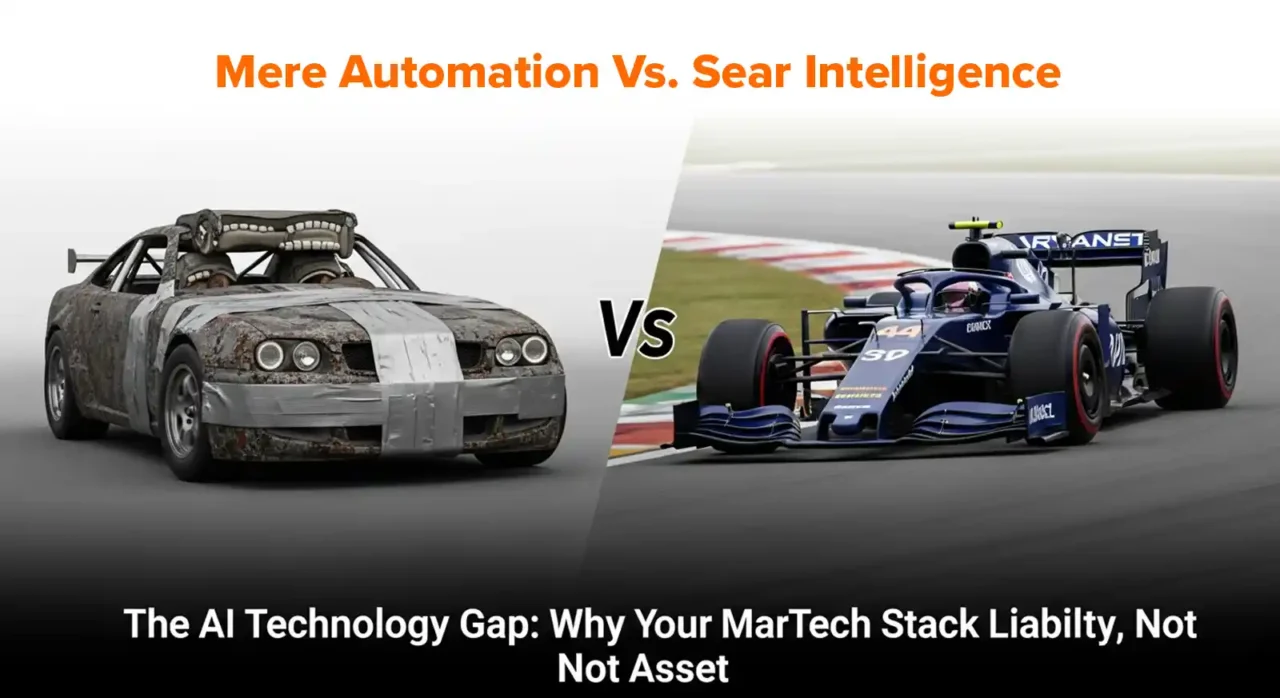The AI Technology Gap: Why Your MarTech Stack is a Liability, Not an Asset
Learn About The AI Technology Gap: Why Your MarTech Stack is a Liability, Not an Asset.
Legacy CRMs and cobbled-together AI apps are costing you more than you think. It’s time to stop paying the “AI Gadget Tax” and embrace a true intelligence system.
Your MarTech Stack Is a Frankenstein Car in a Formula 1 Race
Imagine you’re trying to win a Formula 1 race…
But your team shows up with a car made of duct-taped parts from a lawnmower, a Tesla battery, a 1998 Honda Civic, and a few “smart” gadgets thrown in from a garage sale.
🚫 It’s not fast.
🚫 It’s not integrated.
🚫 And when it breaks, no one knows how to fix it.
That’s your current MarTech stack: a patchwork of legacy CRMs and disconnected AI tools that can’t talk to each other, costing you time, clarity, and ROI.
The Grand Illusion of AI in Marketing
For the better part of a decade, a powerful promise has captivated boardrooms and marketing departments worldwide: the dream of artificial intelligence that can peer into the market, magically identify your perfect customers, and guide them seamlessly toward a purchase.
We were sold a vision of autonomous, intelligent systems that would not just enhance but revolutionize our go-to-market strategies, freeing human talent to focus on creativity and high-level strategy.
At the same time, the machines handled the heavy lifting of data analysis and lead generation.
The reality, as many Chief Marketing Officers are now quietly admitting, has been profoundly disappointing. Instead of intelligent partners, marketing and sales teams often find themselves overwhelmed by the weight of their technology.
They are shackled to complex, brittle workflows, manually pulling reports from a dozen disconnected dashboards. They are ultimately still forced to make high-stakes decisions based on educated guesses about buyer intent.
The promise of proactive intelligence has morphed into a reality of reactive automation. 10 Most In-Demand Types of SEO Services to Focus On in 2025
Why Marketing Agencies Are Struggling With AI
1. Outdated Business Models
Agencies still bill by the hour or deliverables. AI reduces inefficiency, undercutting traditional billing.
2. Superficial AI Adoption
Many agencies just bolt on ChatGPT or Jasper without deep integration or workflow automation.
3. Lack of Technical Talent
Most agencies lack in-house data scientists or AI engineers needed for scalable, custom AI solutions.
4. Struggling to Prove ROI
They can’t measure or attribute AI’s business impact, leaving clients skeptical and ROI unclear.
5. Internal Resistance & Skill Gaps
Creative and client teams fear disruption. Leadership struggles to adapt workflows and org structures.
6. AI-Native Competitors
Tools like Jasper and MatrixLabX offer faster, cheaper, AI-powered marketing platforms that scale easily.
7. Evolving Client Expectations
CMOs expect intelligence, personalization, and speed—traditional agencies can’t keep up without AI.
What Forward-Looking Agencies Are Doing
- Shifting to performance-based pricing
- Hiring AI specialists (MLOps, prompt engineers)
- Automating internal workflows
- Offering AI-as-a-service models
- Educating clients and leading AI adoption
This chasm between expectation and experience is what we refer to as the AI Technology Gap. It’s the vast, costly space between what we label “AI” in our marketing technology (MarTech) stacks and what constitutes true, predictive intelligence.
The inconvenient truth is that the majority of so-called AI in the MarTech landscape is not cognitive or predictive.
It is, at its core, a more advanced form of rules-based automation, a system that can only react to explicit triggers based on logic programmed by humans. It is not thinking; it is executing a checklist, albeit at high speed.
This gap is not merely a semantic issue or an academic inconvenience. It represents a fundamental liability at the heart of the modern enterprise.
It is a drain on resources, a source of profound inefficiency, and, most critically, a barrier to growth that leaves millions in potential revenue on the table.
The very tools meant to provide a competitive edge have become a complex, expensive, and surprisingly unintelligent burden.
As we enter an era where genuine AI is no longer a futuristic concept but a present-day capability, clinging to this legacy model is no longer just a missed opportunity—it’s a strategic blunder.
The Core Problem: Deconstructing the Legacy Stack

To understand why the AI promise has fallen so flat, we must deconstruct the foundational pillars of the conventional MarTech stack: the Customer Relationship Management (CRM) platform and the Marketing Automation Platform (MAP).
These systems, once revolutionary, are now the primary architects of the AI Technology Gap.
2.1 Your CRM is a Reactive Database, Not an Intelligence Engine
At its heart, a CRM is a system of record. It is a meticulously organized, yet fundamentally passive, database.
Its value is entirely dependent on the data it is explicitly fed—contact information from a form fill, deal stages manually updated by a sales representative, or customer service tickets logged by an agent.
It is an exceptional tool for organizing what you already know about your known customers and prospects.
The critical flaw lies in what it doesn’t know. The CRM is blind to the vast ocean of anonymous, yet high-intent, activity happening outside its walled garden.
Industry estimates consistently show that up to 97% of website visitors remain anonymous, browsing, researching, and evaluating solutions without ever filling out a form.
These “unknown unknowns” represent the largest untapped segment of any company’s total addressable market. Yet, to a legacy CRM, they are invisible.
It cannot predict their intent, identify their needs, or recognize that a buying committee from a Fortune 500 company is actively evaluating your pricing page.
The CRM is a historian of the past, dutifully recording events after they happen. It is structurally incapable of predicting the future.
The notoriously high failure rates of CRM implementations, often estimated to be between 30% and 70%, are frequently attributed to issues such as poor user adoption or inaccurate data. But the more profound failure is one of architecture.
Companies are failing to get ROI because they expect intelligence from a tool that was only ever designed to be a filing cabinet.
2.2 Marketing Automation is Brittle and Blind

Marketing automation platforms were created to give the passive CRM a set of active limbs. They operate on a simple, rigid logic: “If a user does X, then we trigger Y.” For example, if a user clicks a link in an email, we add them to a nurture sequence.
If they download a white paper, alert a sales representative. This was a powerful step forward from manual batch-and-blast emails.
However, this rules-based approach fundamentally misunderstands the nuance of human intent. It equates superficial digital body language, such as a click, an open, or a download, with genuine buying interest.
It cannot differentiate between a curious university student researching a paper, a low-level employee at a small business, and a C-suite executive at a target account on the verge of making a multi-million-dollar decision. They all downloaded the same e-book, so the system treats them the same.
The result is a firehose of low-quality “MQLs” (Marketing Qualified Leads) that inundate sales teams, destroying trust between marketing and sales and wasting valuable human hours on fruitless follow-ups.
The automation is working, but it’s blind. It’s a motion-sensor light in an empty warehouse; it faithfully turns on whenever a stray cat wanders by, but it has no idea who is in the building, why they are there, or what they plan to do next.
It reacts to motion but possesses zero awareness.
The “AI Gadget Tax”: The Hidden Cost of a Fragmented Approach

Recognizing the inherent limitations of their core systems, ambitious marketing leaders have tried to patch the gaps. They’ve entered an arms race to acquire a dizzying array of point solutions, each promising to add a layer of “intelligence” to the stack.
A chatbot for the website. A personalization engine for content. A lead scoring tool to prioritize follow-ups. A predictive analytics app to forecast trends. The result is not a cohesive, intelligent system but a monstrous, cobbled-together “Frankenstein Stack.”
This approach has given rise to a hidden, insidious, and deeply damaging cost: the AI Gadget Tax. This tax is not paid solely in subscription fees; its true price is measured in complexity, inefficiency, and lost opportunities.
The Components of the Tax:
- Integration Debt: The first payment is made in technical resources. Making these disparate systems—often built on different data models and with conflicting architectures—talk to each other is a Herculean task. It requires costly, brittle, custom integrations that constantly break, consuming countless hours from engineering and IT teams who should be focused on core product innovation.
- Data Chaos: Each “gadget” creates its silo of data, with its definitions and taxonomies. This fragmentation makes a single source of truth impossible. The chatbot has one view of the customer, the personalization engine has another, and the CRM has a third. This leads to conflicting insights, inconsistent customer experiences, and an inability to form a comprehensive understanding of the buyer’s journey.
- Cognitive Overload: The tax is also levied on your most valuable asset: your people. Marketing and sales teams are forced to become tool jockeys, logging in and out of a half-dozen platforms a day to piece together a fragmented narrative. Their time is spent managing technology rather than engaging with customers. Recent industry surveys have revealed that the share of the marketing technology budget is shrinking. This isn’t due to a dulled appetite, but rather because other leaders, such as the CIO, are taking more control—a clear signal that this uncontrolled sprawl is now seen as unsustainable.
- Lack of Unified Insight: This is the most damaging cost of all. The sum of the parts of the Frankenstein Stack is tragically less than the whole. Without a unified intelligence layer to interpret the signals from all these gadgets in concert, the data is just noise. You have more data than ever, but less clarity. The critical missing ingredient is a unified knowledge core—an underlying “brain” that understands your industry, your market, your buyers, and the context behind their actions. Today’s AI gadgets are tools without wisdom.
Widespread industry research underscores this pain, with marketers consistently reporting that their tech portfolios are too complex and contain costly redundancies.
The desire to consolidate is high, yet the prevailing belief is that no single vendor can provide all the necessary capabilities, trapping companies in a cycle of paying the AI Gadget Tax.
The Differentiator: Why Service-Led Solutions Perpetuate the Problem
Into this chaotic landscape have stepped a new generation of sophisticated marketing agencies and consultancies. Firms like NoGood, Major Tom, and Single Grain have built successful businesses by mastering this complex paradigm.
They are experts at taming the Frankenstein Stack. They can skillfully wire together the disparate gadgets, optimize the brittle workflows, and squeeze incremental performance out of a fundamentally flawed system.
They position themselves as the solution, offering to manage the complexity on behalf of their clients.
Their “AI strategy” often involves leveraging the latest AI-powered tools for media buying, content generation, or social media advertising. They can make the motion-sensor lights in the warehouse flicker more efficiently and with greater precision.
However, it is crucial to recognize the inherent limitation of this model: They manage the “AI Gadget Tax” for you, but they cannot eliminate it. Their business model is inextricably linked to the existence of this fragmented ecosystem.
They are service providers whose value lies in their ability to operate the complex machinery of the legacy stack. They are solving the problem with more services and more complex tool configurations, which perpetuates the core issue.
Their approach remains confined to optimizing within the existing paradigm. They are focused on a media or channel strategy that utilizes AI tools, rather than a foundational intelligence strategy that reimagines the technology core itself.
They are expert navigators using an old, outdated map, guiding you expertly through a territory that should no longer exist.
They are not offering an escape from the tax; they are offering a more comfortable way to pay it.
The fundamental problem—the lack of a unified, predictive intelligence platform—remains unaddressed.
Bridging the Gap with MatrixLabX: The Shift to a True Intelligence System
The only way to win in the new era of marketing is to stop paying the tax. This requires a paradigm shift—moving away from assembling disparate tools and embracing a truly unified intelligence system.
This is the precise gap that MatrixLabX was built to fill. MatrixLabX is not another gadget to be bolted onto your Frankenstein Stack; it is the new foundation.
It is the underlying intelligence layer that the market has been desperately missing.
MatrixLabX directly solves the core problems.

How MatrixLabX directly solves the core problems that legacy systems and cobbled-together solutions cannot:
Problem: Reactive, Rules-Based Systems that only understand explicit actions.
MatrixLabX Solution: A Predictive Intent Engine. By analyzing thousands of real-time behavioral, firmographic, and contextual signals, MatrixLabX moves beyond simple “if-this-then-that” logic.
It forecasts buyer behavior and identifies in-market accounts before they ever fill out a form. It doesn’t just see a click; it understands the nuanced intent behind it, distinguishing the tire-kicker from the ready-to-buy executive.
Problem: Blindness to the 97% of Anonymous Prospects who represent the majority of your market.
MatrixLabX Solution: A proprietary Identity Graph. This sophisticated technology de-anonymizes high-value anonymous website visitors, linking them to specific accounts and even key individuals within those accounts.
It shines a light on your hidden pipeline, transforming your website from a passive brochure into an active intelligence-gathering asset.
Problem: The crippling “AI Gadget Tax” is born from integration debt, data chaos, and cognitive overload.
MatrixLabX Solution: A Unified Platform Architecture. By providing a single, cohesive system for data, analytics, and activation, MatrixLabX eliminates the need for a dozen point solutions.
It provides a single source of truth for the entire go-to-market team, slashing integration costs, eliminating data chaos, and freeing your talent to focus on what matters.
Problem: The lack of business and industry context makes other AI tools “wisdom-blind.”
MatrixLabX Solution: An Industry Knowledge Graph. This is the brain of the operation. MatrixLabX is not a generic tool; it is pre-built with a deep, semantic understanding of your specific industry’s ecosystem, the key players, competitive dynamics, buyer journeys, and market trends.
This built-in knowledge provides the essential context that turns raw data into actionable, strategic intelligence. It’s well-documented that companies seeing the most financial impact from AI are those that fundamentally redesign their workflows; MatrixLabX provides the engine for that exact redesign.
Conclusion: Stop Renting Tools, Start Owning Intelligence
The path forward is clear. The future of competitive advantage will not be determined by who has the most AI gadgets in their MarTech stack.
It will be won by those who have the most cohesive, predictive, and actionable intelligence.
Continuing to operate with a legacy CRM and a patchwork of reactive automation tools is no longer a viable strategy.
It is an active liability that forces you to pay the AI Gadget Tax in wasted budget, squandered human potential, and, most importantly, lost revenue.
Hiring an agency to manage this complexity may feel like a solution, but it is merely an anesthetic for a problem that requires surgery. It makes you more comfortable with a fundamentally broken model.
Today, business leaders face a clear choice:
- Option A: Continue to invest in a reactive, fragmented legacy stack. Continue to pay the AI Gadget Tax in both direct costs and substantial opportunity costs. Devote your team’s energy to managing tools rather than customers, and accept that you are blind to the vast majority of your potential market.
- Option B: Adopt a true intelligence system. Bridge the AI Technology Gap with a platform that was built from the ground up to unify data, predict buyer intent, and eliminate the tax for good.
The choice is between renting an ever-growing collection of tools or finally owning a true intelligence asset.
Are you ready to bridge the AI Technology Gap? Stop paying the gadget tax and see what a true intelligence system can do. Discover MatrixLabX.
Performance Pricing Configurator
Build your plan and see how our success is tied to yours.
Step 1: Select Your Industry
This determines the KPIs we use to measure success.
Step 2: Your Revenue
Please provide your company’s revenue details.
Minimum of $3,000,000 required.
Your estimated revenue growth for the next year.
Step 3: Choose Your Service Tier
Select the AIPad modules from MatrixLabX to power your growth.
Select Your AIPads
Step 4: Enter Your Current Data
This helps us understand your baseline performance.
Please select an industry in Step 1.
Your Performance Quote
Your custom quote will appear here once you complete the steps.

